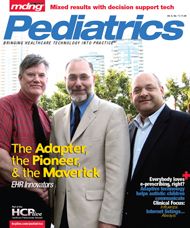Publication
Article
MDNG Pediatrics
3 Questions... with Gail Teachman, BScOT, MSc, OT Reg(Ont)
Gail Teachman, BScOT, MSc, OT Reg(Ont), discusses adoptive communication devices for children with autism.
Teachman, an occupational therapist at Bloorview Kids Rehab in Toronto, Canada, a consultant in the area of augmentative and alternative communication (AAC), and member of the International Society for Augmentative & Alternative Communication (ISAAC), discusses adaptive communication devices for children with autism.
1 What is your main responsibility as an occupational therapist at Bloorview Kids Rehab?
I work in the communication and writing aids program. Each player on the team makes specific contributions and has certain perspectives. The occupational therapist (OT) typically enables people to participate in the various occupational roles within their lives. In this service, my role is to help our young clients to use the communication that we help to introduce and the options available to them. The OTs will also look at the skills that might not be as visible to everybody and how that young person can use the device or system in front of them. Some clients might have a book of symbols organized in a specific way and use the book by pointing to the symbols. If they have a motor impairment, the OT might look to find a way to ensure that the design of the book is done in a way so that a child can manage it.
2 What technologies do you use at Bloorview when treating children with autism?
We prescribe software, hardware, or integrated technology to target two main areas: face-to-face communication and written communication. One technology that we use is a speechgenerating device; a Palm handheld that anyone can buy. A company purchased the rights and added their own software (the voice, the speakers, etc) and put it in a heavy-duty casing, turning it into a speech-generating device. There are devices being developed by other companies that offer similar capabilities. Part of our job is to meet with the family, school, and whoever else assists the child to help make an informed choice of which device to use and try out.
There are software programs that can help children to write. One such program is Word Prediction; they start typing a word, and the software will predict the ending of the word. Another software program that can help autistic children combines Word Prediction and speech input into one. Certain words are said to a computer program and the program can predict the words a child is trying to say. Text-to-speech technology is also very common and helpful for the children. They can type on a computer that will read back what is being typed. They can hear misspelled words prior to completing a sentence, making it easier for them to edit.
Integrated devices are a combination of hardware and software programs and are now becoming more common. A child might have a small portable tool that runs speech generating software with some additional tools enabling them to talk to other students. With the push of a single button, the child could ask, “What did you do over the weekend?” and then switch to a different program in class to complete written assignments.
3 How have technological advances helped with neurological disorders like autism?
I think the main impact is that technology helps the children feel included. Based on my personal graduate-level research, I learned that from a child’s point of view, being included is what they want most. Having a device with speech capabilities allows them to become active participants, because now they have a voice. There’s a quote that’s repeated a lot in this field from a child’s point of view: “Just because I can’t talk, doesn’t mean that I don’t have something to say.” One of the things I love about Bloorview is related to its new slogan— “From disability to possibility”—which is really meaningful for a lot of OTs, because it’s what we’ve learned in our work over the years. We’re starting to see a world where technology allows people to see those possibilities.
